belt MITSUBISHI ECLIPSE CROSS 2020 (in English) Owner's Guide
[x] Cancel search | Manufacturer: MITSUBISHI, Model Year: 2020, Model line: ECLIPSE CROSS, Model: MITSUBISHI ECLIPSE CROSS 2020Pages: 427, PDF Size: 78.05 MB
Page 70 of 427
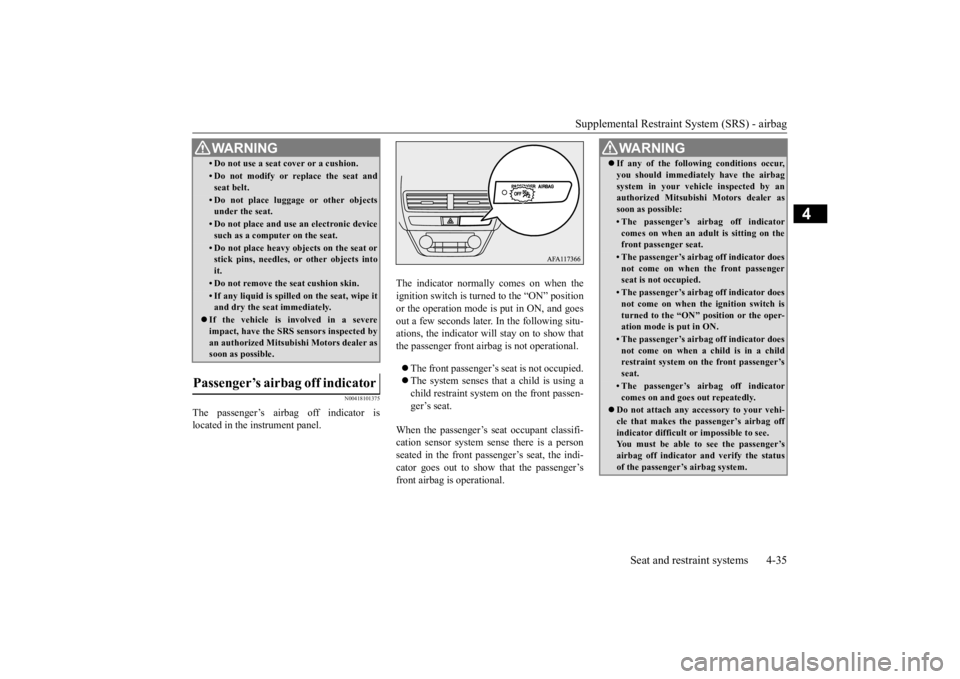
Supplemental Restraint System (SRS) - airbag
Seat and restraint systems 4-35
4
N00418101375
The passenger’s airbag off indicator is located in the instrument panel.
The indicator normally comes on when the ignition switch is turned to the “ON” positionor the operation mode is put in ON, and goes out a few seconds later. In the following situ- ations, the indicator will stay on to show thatthe passenger front airbag is not operational. The front passenger’s seat is not occupied. The system senses that a child is using a child restraint system on the front passen- ger’s seat.
When the passenger’s seat occupant classifi- cation sensor system sense there is a person seated in the front passenger’s seat, the indi- cator goes out to show that the passenger’sfront airbag is operational.
• Do not use a seat cover or a cushion.• Do not modify or replace the seat and seat belt.• Do not place luggage or other objectsunder the seat.• Do not place and use an electronic devicesuch as a computer on the seat.• Do not place heavy objects on the seat orstick pins, needles, or other objects into it.• Do not remove the seat cushion skin.• If any liquid is spilled on the seat, wipe it and dry the seat immediately.
If the vehicle is involved in a severe impact, have the SRS sensors inspected by an authorized Mitsubishi Motors dealer assoon as possible.
Passenger’s airbag off indicator
WA R N I N G
WA R N I N G If any of the following conditions occur, you should immediately have the airbag system in your vehicle inspected by an authorized Mitsubishi Motors dealer as soon as possible:• The passenger’s airbag off indicatorcomes on when an adult is sitting on thefront passenger seat.• The passenger’s airbag off indicator doesnot come on when the front passenger seat is not occupied.• The passenger’s airbag off indicator doesnot come on when the ignition switch is turned to the “ON” position or the oper-ation mode is put in ON.• The passenger’s airbag off indicator doesnot come on when a child is in a child restraint system on the front passenger’s seat.• The passenger’s airbag off indicatorcomes on and goes out repeatedly.
Do not attach any accessory to your vehi- cle that makes the passenger’s airbag offindicator difficult or impossible to see. You must be able to see the passenger’s airbag off indicator and verify the statusof the passenger’s airbag system.
BK0277700US.bo
ok 35 ページ 2019年3月8日 金曜日 午前9時23分
Page 71 of 427
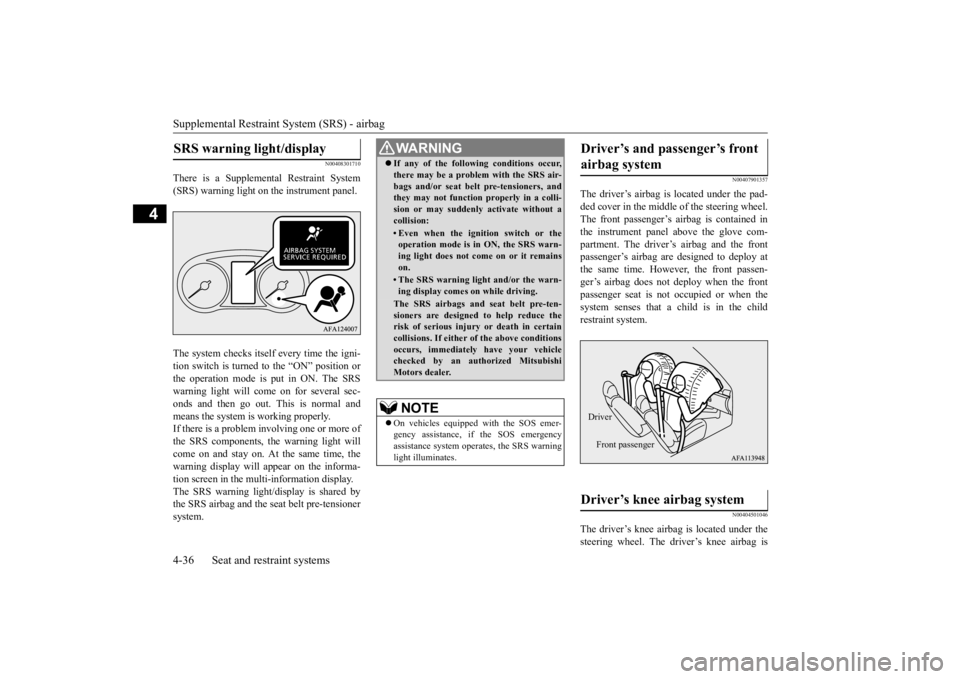
Supplemental Restraint System (SRS) - airbag 4-36 Seat and restraint systems
4
N00408301710
There is a Supplemental Restraint System (SRS) warning light on the instrument panel. The system checks itself every time the igni- tion switch is turned to the “ON” position orthe operation mode is put in ON. The SRSwarning light will come on for several sec- onds and then go out. This is normal and means the system is working properly.If there is a problem involving one or more of the SRS components, the warning light will come on and stay on. At the same time, thewarning display will appear on the informa- tion screen in the multi-information display. The SRS warning light/display is shared bythe SRS airbag and the seat belt pre-tensioner system.
N00407901357
The driver’s airbag is located under the pad- ded cover in the middle of the steering wheel. The front passenger’s airbag is contained in the instrument panel above the glove com-partment. The driver’s airbag and the front passenger’s airbag are designed to deploy at the same time. However,
the front passen-
ger’s airbag does not deploy when the frontpassenger seat is not occupied or when the system senses that a child is in the child restraint system.
N00404501046
The driver’s knee airbag
is located under the
steering wheel. The driver’s knee airbag is
SRS warning light/display
WA R N I N G If any of the following conditions occur, there may be a problem with the SRS air- bags and/or seat belt pre-tensioners, and they may not function properly in a colli- sion or may suddenly activate without acollision:• Even when the ignition switch or theoperation mode is in ON, the SRS warn- ing light does not come on or it remains on.• The SRS warning light and/or the warn-ing display comes on while driving.The SRS airbags and seat belt pre-ten-sioners are designed to help reduce therisk of serious injury or death in certain collisions. If either of the above conditions occurs, immediately have your vehiclechecked by an authorized Mitsubishi Motors dealer.NOTE
On vehicles equipped with the SOS emer- gency assistance, if the SOS emergency assistance system operates, the SRS warning light illuminates.
Driver’s and passenger’s front airbag system Driver’s knee airbag system Driver Front passenger
BK0277700US.bo
ok 36 ページ 2019年3月8日 金曜日 午前9時23分
Page 73 of 427
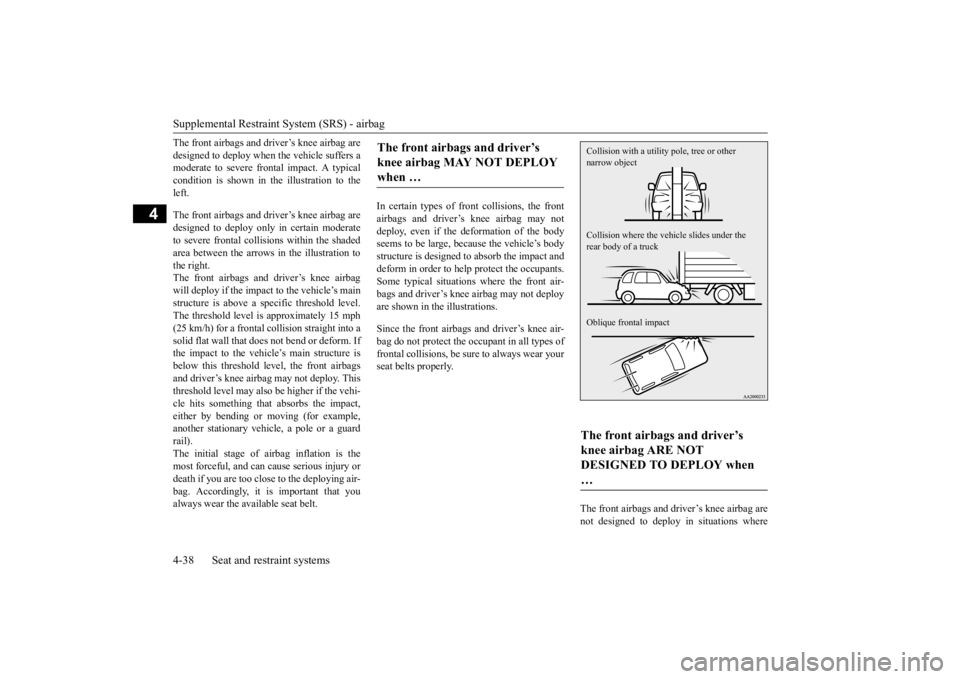
Supplemental Restraint System (SRS) - airbag 4-38 Seat and restraint systems
4
The front airbags and driver’s knee airbag are designed to deploy when the vehicle suffers a moderate to severe frontal impact. A typical condition is shown in the illustration to theleft. The front airbags and driver’s knee airbag are designed to deploy only in certain moderate to severe frontal collisions within the shadedarea between the arrows in the illustration to the right. The front airbags and driver’s knee airbagwill deploy if the impact to the vehicle’s mainstructure is above a specific threshold level. The threshold level is approximately 15 mph (25 km/h) for a frontal collision straight into asolid flat wall that does not bend or deform. If the impact to the vehicle’s main structure is below this threshold level, the front airbagsand driver’s knee airbag may not deploy. This threshold level may also be higher if the vehi- cle hits something that absorbs the impact,either by bending or moving (for example, another stationary vehicle, a pole or a guard rail).The initial stage of airbag inflation is the most forceful, and can cause serious injury or death if you are too close to the deploying air-bag. Accordingly, it is important that you always wear the available seat belt.
In certain types of front collisions, the front airbags and driver’s knee airbag may not deploy, even if the deformation of the body seems to be large, because the vehicle’s bodystructure is designed to absorb the impact and deform in order to help protect the occupants. Some typical situations where the front air-bags and driver’s knee airbag may not deployare shown in the illustrations. Since the front airbags and driver’s knee air- bag do not protect the occupant in all types of frontal collisions, be sure to always wear yourseat belts properly.
The front airbags and driver’s knee airbag are not designed to deploy in situations where
The front airbags and driver’s knee airbag MAY NOT DEPLOY when …
The front airbags and driver’s knee airbag ARE NOT DESIGNED TO DEPLOY when … Collision with a utility
pole, tree or other
narrow object Collision where the vehi
cle slides under the
rear body of a truck Oblique frontal impact
BK0277700US.bo
ok 38 ページ 2019年3月8日 金曜日 午前9時23分
Page 74 of 427
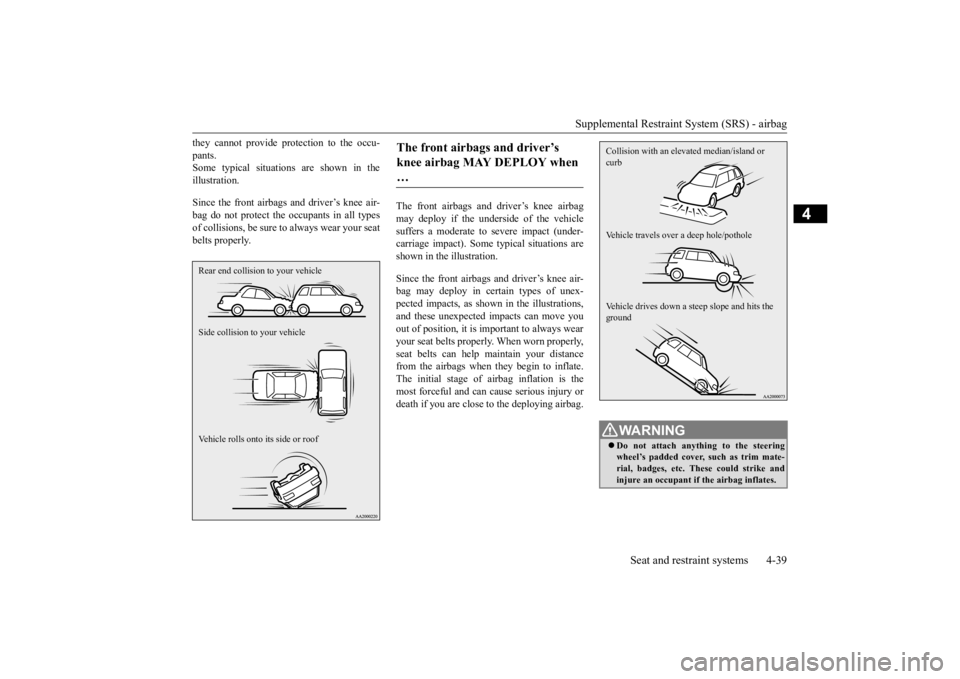
Supplemental Restraint System (SRS) - airbag
Seat and restraint systems 4-39
4
they cannot provide protection to the occu- pants. Some typical situations are shown in the illustration. Since the front airbags and driver’s knee air- bag do not protect the occupants in all types of collisions, be sure to
always wear your seat
belts properly.
The front airbags and driver’s knee airbag may deploy if the underside of the vehicle suffers a moderate to severe impact (under- carriage impact). Some typical situations areshown in the illustration. Since the front airbags and driver’s knee air- bag may deploy in certain types of unex- pected impacts, as shown in the illustrations, and these unexpected impacts can move youout of position, it is important to always wear your seat belts properly. When worn properly, seat belts can help maintain your distancefrom the airbags when they begin to inflate. The initial stage of airbag inflation is the most forceful and can cause serious injury ordeath if you are close
to the deploying airbag.
Rear end collision to your vehicle Side collision to your vehicle Vehicle rolls onto its side or roof
The front airbags and driver’s knee airbag MAY DEPLOY when …
WA R N I N G Do not attach anything to the steering wheel’s padded cover, such as trim mate-rial, badges, etc. These could strike and injure an occupant if the airbag inflates.Collision with an elevated median/island or curb Vehicle travels over a deep hole/pothole Vehicle drives down a steep slope and hits the ground
BK0277700US.bo
ok 39 ページ 2019年3月8日 金曜日 午前9時23分
Page 78 of 427
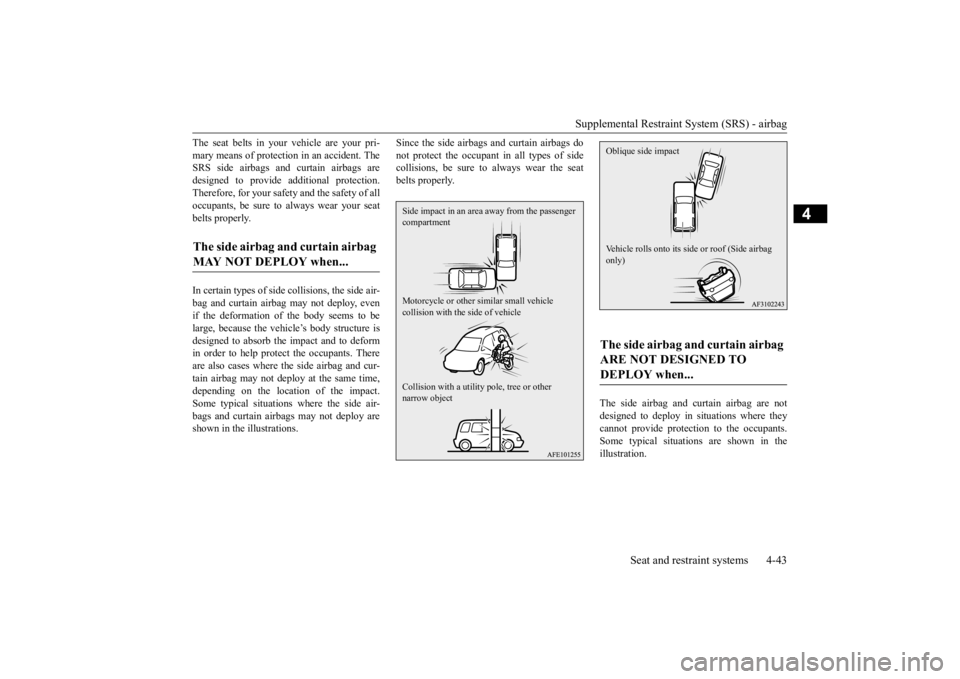
Supplemental Restraint System (SRS) - airbag
Seat and restraint systems 4-43
4
The seat belts in your vehicle are your pri- mary means of protection in an accident. The SRS side airbags and curtain airbags are designed to provide additional protection.Therefore, for your safety and the safety of all occupants, be sure to always wear your seat belts properly. In certain types of side
collisions, the side air-
bag and curtain airbag may not deploy, even if the deformation of the body seems to be large, because the vehicle’s body structure isdesigned to absorb the impact and to deform in order to help protect the occupants. There are also cases where the side airbag and cur-tain airbag may not deploy at the same time, depending on the location of the impact. Some typical situations where the side air-bags and curtain airbags may not deploy are shown in the illustrations.
Since the side airbags and curtain airbags do not protect the occupant in all types of side collisions, be sure to always wear the seat belts properly.
The side airbag and curtain airbag are not designed to deploy in situations where they cannot provide protection to the occupants.Some typical situations are shown in the illustration.
The side airbag and curtain airbag MAY NOT DEPLOY when...
Side impact in an area
away from the passenger
compartment Motorcycle or other similar small vehicle collision with the side of vehicle Collision with a utility
pole, tree or other
narrow object
The side airbag and curtain airbag ARE NOT DESIGNED TO DEPLOY when... Oblique side impact Vehicle rolls onto its side
or roof (Side airbag
only)
BK0277700US.bo
ok 43 ページ 2019年3月8日 金曜日 午前9時23分
Page 79 of 427
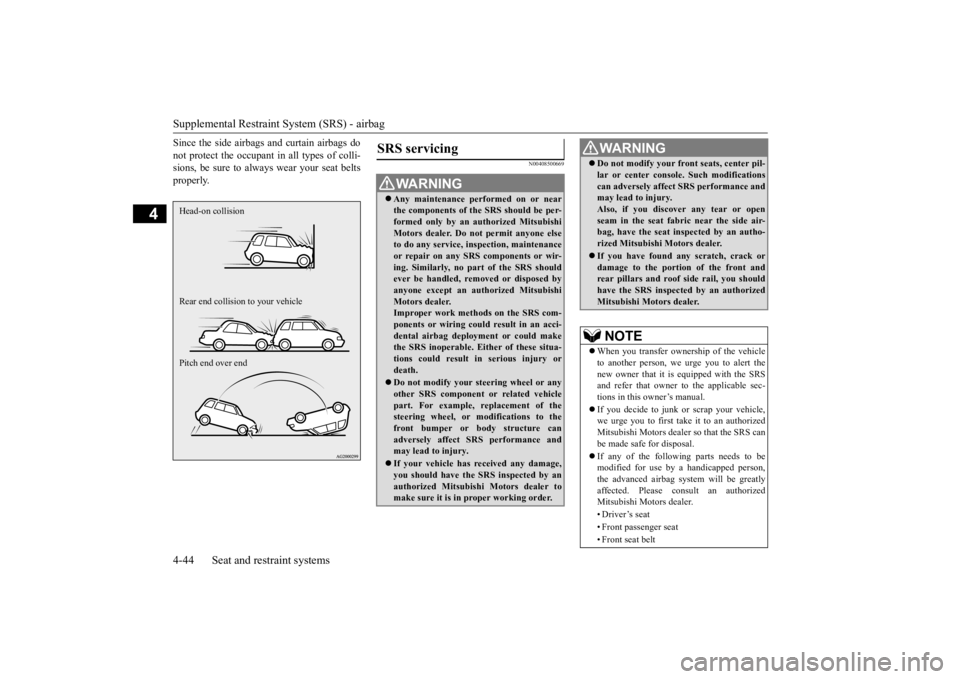
Supplemental Restraint System (SRS) - airbag 4-44 Seat and restraint systems
4
Since the side airbags and curtain airbags do not protect the occupant in all types of colli- sions, be sure to always wear your seat belts properly.
N00408500669
Head-on collision Rear end collision to your vehicle Pitch end over end
SRS servicing
WA R N I N G Any maintenance performed on or near the components of the SRS should be per- formed only by an authorized Mitsubishi Motors dealer. Do not permit anyone elseto do any service, inspection, maintenance or repair on any SRS components or wir- ing. Similarly, no part of the SRS shouldever be handled, removed or disposed by anyone except an authorized Mitsubishi Motors dealer.Improper work methods on the SRS com- ponents or wiring could result in an acci- dental airbag deployment or could makethe SRS inoperable. Either of these situa- tions could result in serious injury or death. Do not modify your steering wheel or any other SRS component or related vehiclepart. For example, replacement of the steering wheel, or modifications to the front bumper or body structure canadversely affect SRS performance and may lead to injury. If your vehicle has received any damage, you should have the SRS inspected by an authorized Mitsubishi Motors dealer to make sure it is in proper working order.
Do not modify your front seats, center pil- lar or center console. Such modifications can adversely affect SRS performance and may lead to injury. Also, if you discover any tear or openseam in the seat fabric near the side air- bag, have the seat inspected by an autho- rized Mitsubishi Motors dealer. If you have found any scratch, crack or damage to the portion of the front andrear pillars and roof side rail, you should have the SRS inspected by an authorized Mitsubishi Motors dealer.NOTE
When you transfer ownership of the vehicle to another person, we urge you to alert the new owner that it is equipped with the SRS and refer that owner to the applicable sec-tions in this owner’s manual. If you decide to junk or scrap your vehicle, we urge you to first take
it to an authorized
Mitsubishi Motors dealer so that the SRS can be made safe for disposal. If any of the following parts needs to be modified for use by a handicapped person, the advanced airbag system will be greatly affected. Please consult an authorizedMitsubishi Motors dealer. • Driver’s seat• Front passenger seat • Front seat beltWA R N I N G
BK0277700US.bo
ok 44 ページ 2019年3月8日 金曜日 午前9時23分
Page 106 of 427
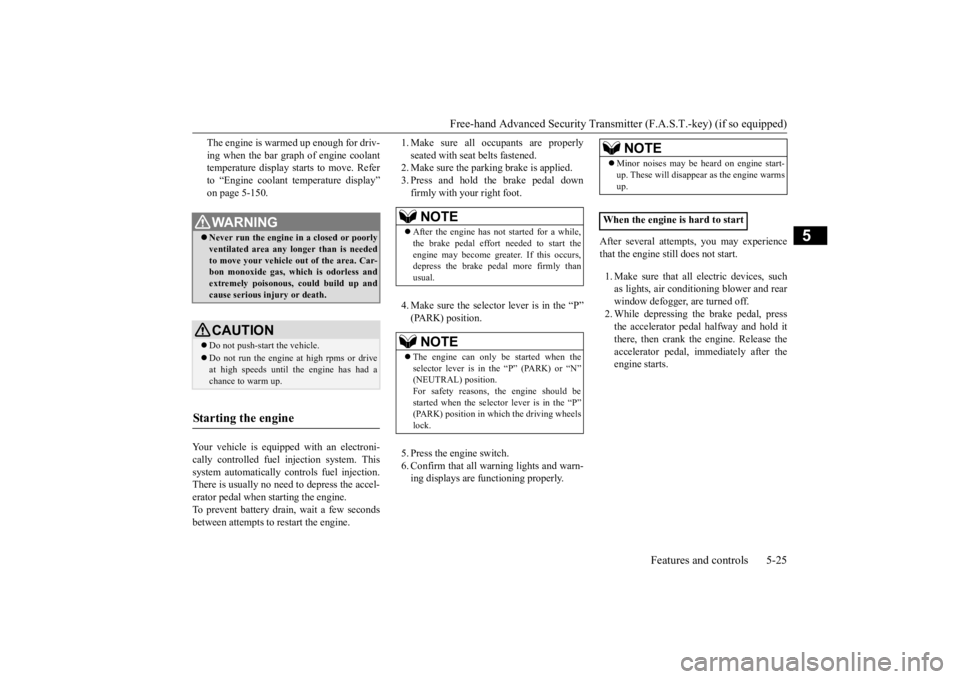
Free-hand Advanced Security Transmit
ter (F.A.S.T.-key) (if so equipped)
Features and controls 5-25
5
The engine is warmed up enough for driv- ing when the bar graph of engine coolant temperature display starts to move. Refer to “Engine coolant temperature display”on page 5-150.
Your vehicle is equipped with an electroni- cally controlled fuel injection system. This system automatically controls fuel injection.There is usually no need to depress the accel- erator pedal when starting the engine. To prevent battery drain, wait a few secondsbetween attempts to restart the engine.
1. Make sure all occupants are properly seated with seat belts fastened. 2. Make sure the parking brake is applied. 3. Press and hold the brake pedal downfirmly with your right foot. 4. Make sure the selector lever is in the “P” (PARK) position. 5. Press the engine switch. 6. Confirm that all warning lights and warn- ing displays are functioning properly.
After several attempts, you may experience that the engine still does not start. 1. Make sure that all electric devices, such as lights, air conditioning blower and rearwindow defogger, are turned off. 2. While depressing the brake pedal, press the accelerator pedal halfway and hold itthere, then crank the engine. Release the accelerator pedal, immediately after the engine starts.
WA R N I N G Never run the engine in a closed or poorly ventilated area any longer than is needed to move your vehicle out of the area. Car-bon monoxide gas, which is odorless and extremely poisonous, could build up and cause serious injury or death.CAUTION Do not push-start the vehicle.Do not run the engine at high rpms or drive at high speeds until the engine has had a chance to warm up.
Starting the engine
NOTE
After the engine has not started for a while, the brake pedal effort needed to start theengine may become greater. If this occurs, depress the brake pedal more firmly than usual.NOTE
The engine can only be started when the selector lever is in the “P” (PARK) or “N”(NEUTRAL) position. For safety reasons, the engine should be started when the selector lever is in the “P”(PARK) position in which the driving wheels lock.
NOTE
Minor noises may be heard on engine start- up. These will disappear as the engine warms up.
When the engine is hard to start
BK0277700US.bo
ok 25 ページ 2019年3月8日 金曜日 午前9時23分
Page 116 of 427
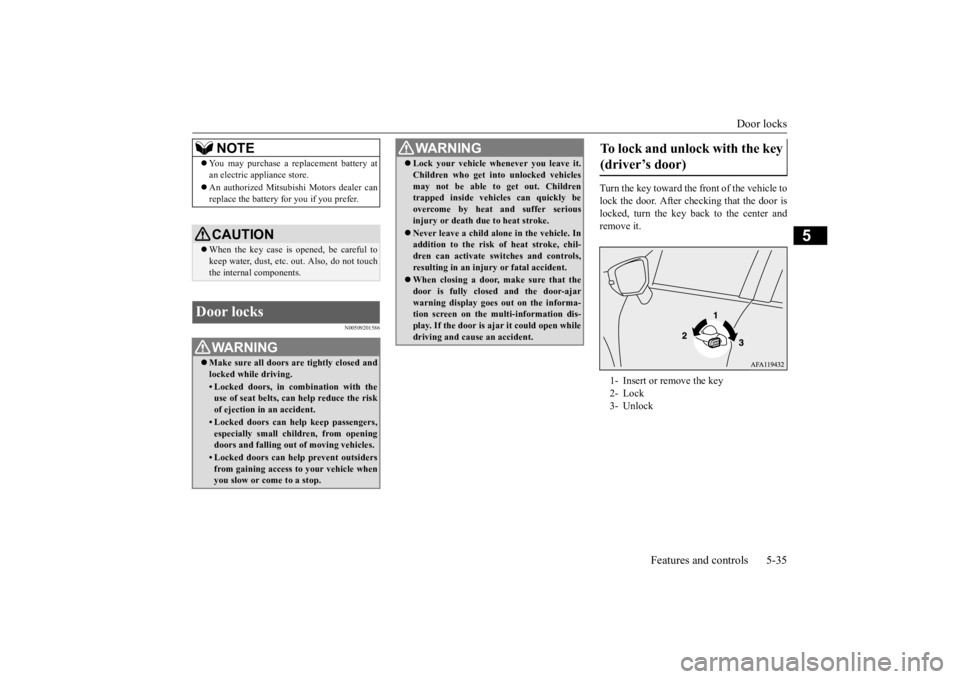
Door locks
Features and controls 5-35
5
N00509201586
Turn the key toward the front of the vehicle to lock the door. After ch
ecking that the door is
locked, turn the key back to the center and remove it.
NOTE
You may purchase a replacement battery at an electric appliance store. An authorized Mitsubishi Motors dealer can replace the battery for you if you prefer.CAUTION When the key case is opened, be careful to keep water, dust, etc.
out. Also, do not touch
the internal components.
Door locks
WA R N I N G Make sure all doors are tightly closed and locked while driving.• Locked doors, in combination with theuse of seat belts, can help reduce the risk of ejection in an accident.• Locked doors can help keep passengers,especially small children, from opening doors and falling out of moving vehicles.• Locked doors can help prevent outsidersfrom gaining access to your vehicle when you slow or come to a stop.
Lock your vehicle whenever you leave it. Children who get into unlocked vehicles may not be able to get out. Children trapped inside vehicles can quickly be overcome by heat and suffer seriousinjury or death due to heat stroke. Never leave a child alone in the vehicle. In addition to the risk of heat stroke, chil- dren can activate switches and controls, resulting in an injury or fatal accident. When closing a door, make sure that the door is fully closed and the door-ajarwarning display goes out on the informa- tion screen on the multi-information dis- play. If the door is ajar it could open whiledriving and cause an accident.WA R N I N G
To lock and unlock with the key (driver’s door) 1- Insert or remove the key 2- Lock 3- Unlock
BK0277700US.bo
ok 35 ページ 2019年3月8日 金曜日 午前9時23分
Page 133 of 427
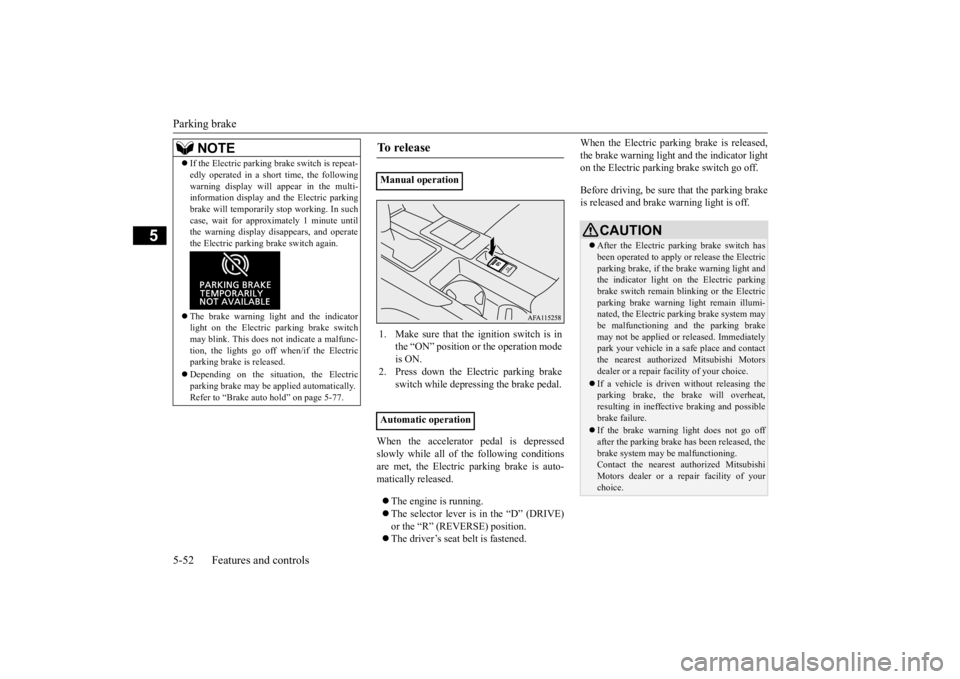
Parking brake 5-52 Features and controls
5
When the accelerator pedal is depressed slowly while all of the following conditionsare met, the Electric parking brake is auto- matically released. The engine is running. The selector lever is in the “D” (DRIVE) or the “R” (REVERSE) position. The driver’s seat belt is fastened.
When the Electric parking brake is released, the brake warning light and the indicator light on the Electric parking brake switch go off. Before driving, be sure that the parking brake is released and brake warning light is off.
If the Electric parking brake switch is repeat- edly operated in a short time, the following warning display will appear in the multi- information display and the Electric parking brake will temporarily stop working. In suchcase, wait for approximately 1 minute until the warning display disappears, and operate the Electric parking brake switch again. The brake warning light and the indicator light on the Electric parking brake switch may blink. This does not indicate a malfunc-tion, the lights go off when/if the Electric parking brake is released. Depending on the situation, the Electric parking brake may be applied automatically. Refer to “Brake auto hold” on page 5-77.NOTE
To release
Manual operation 1. Make sure that the ignition switch is in
the “ON” position or the operation mode is ON.
2. Press down the Electric parking brake
switch while depressing the brake pedal.
Automatic operation
CAUTION After the Electric parking brake switch has been operated to apply or release the Electricparking brake, if the brake warning light and the indicator light on the Electric parking brake switch remain blinking or the Electricparking brake warning light remain illumi- nated, the Electric parking brake system may be malfunctioning and the parking brakemay not be applied or released. Immediately park your vehicle in a safe place and contact the nearest authorized Mitsubishi Motorsdealer or a repair facility of your choice. If a vehicle is driven without releasing the parking brake, the brake will overheat, resulting in ineffective braking and possible brake failure. If the brake warning light does not go off after the parking brake has been released, thebrake system may be malfunctioning. Contact the nearest authorized Mitsubishi Motors dealer or a repair facility of your choice.
BK0277700US.bo
ok 52 ページ 2019年3月8日 金曜日 午前9時23分
Page 143 of 427
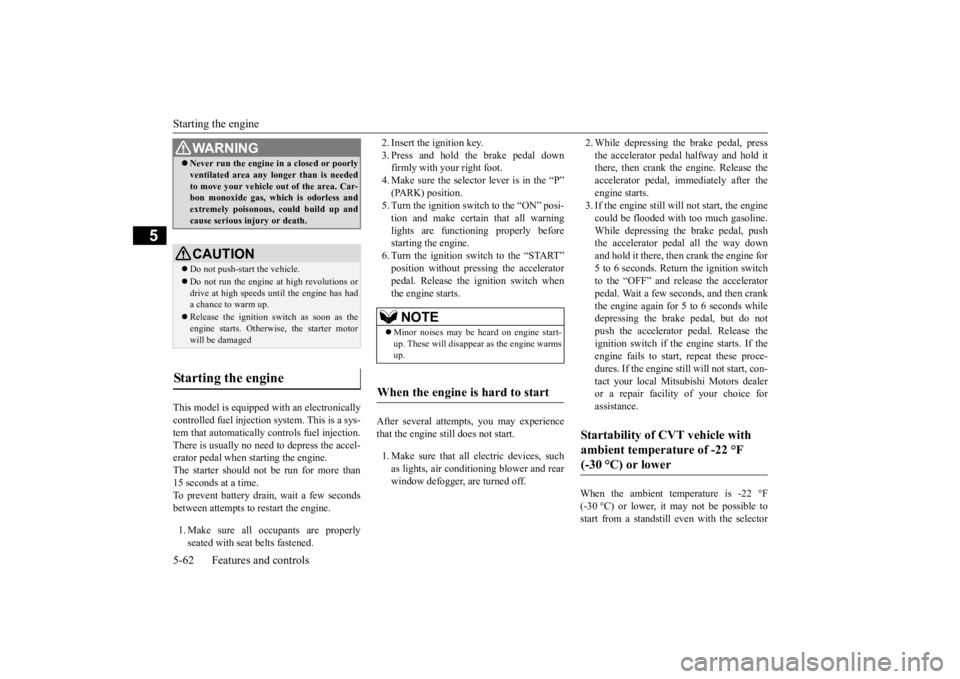
Starting the engine 5-62 Features and controls
5
This model is equipped with an electronically controlled fuel injection system. This is a sys- tem that automatically controls fuel injection.There is usually no need to depress the accel- erator pedal when starting the engine. The starter should not be run for more than15 seconds at a time. To prevent battery drain, wait a few seconds between attempts to restart the engine. 1. Make sure all occupants are properly seated with seat belts fastened.
2. Insert the ignition key. 3. Press and hold the brake pedal down firmly with your right foot. 4. Make sure the selector lever is in the “P”(PARK) position. 5. Turn the ignition switch to the “ON” posi- tion and make certain that all warninglights are functioning properly before starting the engine. 6. Turn the ignition switch to the “START”position without pressing the acceleratorpedal. Release the ignition switch when the engine starts.
After several attempts, you may experience that the engine still does not start. 1. Make sure that all electric devices, such as lights, air conditioning blower and rearwindow defogger, are turned off.
2. While depressing the brake pedal, press the accelerator pedal halfway and hold it there, then crank the engine. Release the accelerator pedal, immediately after theengine starts. 3. If the engine still will not start, the engine could be flooded with too much gasoline.While depressing the brake pedal, push the accelerator pedal all the way down and hold it there, then crank the engine for5 to 6 seconds. Return the ignition switchto the “OFF” and release the accelerator pedal. Wait a few seconds, and then crank the engine again for 5 to 6 seconds whiledepressing the brake pedal, but do not push the accelerator pedal. Release the ignition switch if the engine starts. If theengine fails to start, repeat these proce- dures. If the engine st
ill will not start, con-
tact your local Mitsubishi Motors dealeror a repair facility of your choice for assistance.
When the ambient temperature is -22 °F (-30 °C) or lower, it may not be possible tostart from a standstill even with the selector
WA R N I N G Never run the engine in a closed or poorly ventilated area any longer than is needed to move your vehicle out of the area. Car- bon monoxide gas, which is odorless and extremely poisonous, could build up andcause serious injury or death.CAUTION Do not push-start the vehicle.Do not run the engine at high revolutions or drive at high speeds until the engine has hada chance to warm up. Release the ignition switch as soon as the engine starts. Otherwise, the starter motor will be damaged
Starting the engine
NOTE
Minor noises may be heard on engine start- up. These will disappear as the engine warms up.
When the engine is hard to start
Startability of CVT vehicle with ambient temperature of -22 °F (-30 °C) or lower
BK0277700US.bo
ok 62 ページ 2019年3月8日 金曜日 午前9時23分